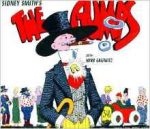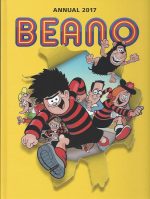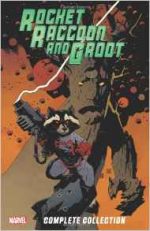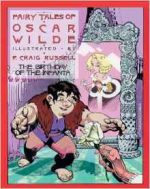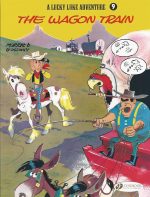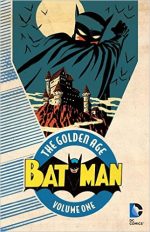
By Bob Kane, Bill Finger, Gardner Fox, Whitney Ellsworth, Sheldon Moldoff, Jerry Robinson, George Roussos & various (DC Comics)
ISBN: 978-1-4012-6333-1
Win’s Christmas Gift Recommendation: Vintage Comicbook Perfection… 10/10
For anyone who’s read more than a few of these posts, my tastes should be fairly apparent, but in case you’re in any doubt, here’s a flat-out confession: I’m that shabby, possibly crazy old geezer muttering at the checkout about how things were better before, and all new things are crap and not the same and…
You get the picture. Now, ignore all that. It’s true but it’s not relevant here.
Batman: The Golden Age is the latest paperback-format (there’s also a weightier, pricier but more capacious hardback Omnibus available) re-presentation of the Dark Knight’s earliest exploits.
Set in original chronological order, it forgoes glossy, high-definition paper and reproduction techniques in favour of a newsprint-adjacent feel and the same flat, bright-yet-muted colour palette which graced the originals.
There’s no fuss, fiddle or Foreword, and the book steams straight into the meat of the matter with the accumulated first year and a half of material masked mystery-man plus all those stunning covers spanning Detective Comics #27-45; Batman #1-3 and the Dynamic Duo’s story from New York World’s Fair Comics 1940; cumulatively covering all the groundbreaking escapades from May 1939-November 1940.
As Eny Fule Kno, Detective #27 spotlighted the Gotham Guardian’s debut in the ‘Case of the Chemical Syndicate!’ by Bob Kane and close collaborator/co-originator Bill Finger.
This spartan, understated yarn introduced dilettante playboy criminologist Bruce Wayne, drawn into a straightforward crime-caper wherein a cabal of industrialists were successively murdered. The killings stopped when an eerie figure dubbed “The Bat-Man†intruded on Police Commissioner Gordon‘s stalled investigation and ruthlessly exposed and dealt with the hidden killer.
The next issue saw the fugitive vigilante return to crush ‘Frenchy Blake’s Jewel Gang’ before encountering his very first psychopathic killer and returning villain in Detective #29. Gardner Fox scripted the next few adventures beginning with ‘The Batman Meets Doctor Death’, featuring a deadly duel of wits with deranged, greedy general practitioner Karl Hellfern and his assorted instruments of murder: the most destructive and diabolical of which was sinister Asiatic manservant Jabah…
Confident of their new villain’s potential, Kane, Fox and inker Sheldon Mayer encored the mad medic for the next instalment in ‘The Return of Doctor Death’, before Fox and Finger co-scripted a 2-part shocker which introduced the first bat-plane, Bruce’s girlfriend Julie Madison and undead horror The Monk in an expansive, globe-girdling spooky saga. ‘Batman Versus the Vampire’ concluded in an epic chase across Eastern Europe and a spectacular climax in a monster-filled castle in issue #32.
Detective Comics #33 featured Fox & Kane’s ‘The Batman Wars Against the Dirigible of Doom’: a blockbusting disaster thriller which just casually slipped in the secret origin of the Gotham Guardian, as mere prelude to intoxicating air-pirate action, after which Euro-trash dastard Duc D’Orterre found his uncanny science and unsavoury appetites no match for the mighty Batman in ‘Peril in Paris’.
Bill Finger returned as lead scripter in issue #35, pitting the Cowled Crusader against crazed cultists murdering everyone who had seen their sacred jewel in ‘The Case of the Ruby Idol’ – although the many deaths were actually caused by a far more prosaic villain, after which grotesque criminal genius ‘Professor Hugo Strange’ (inked by new kid Jerry Robinson) debuted with his murderous man-made fog and lightning machine in #36, and all-pervasive enemy agents ‘The Spies’ ultimately proved no match for the vengeful masked Manhunter in #37.
Detective Comics #38 (April 1940) changed the landscape of comicbooks forever with the introduction of ‘Robin, The Boy Wonder’: child trapeze artist Dick Grayson whose parents were murdered before his eyes and who thereafter joined Batman in a lifelong quest for justice, by bringing to justice mobster mad dog Boss Zucco…
After the Flying Grayson’s killers were captured, Batman #1 (Spring 1940) opened proceedings with a recycled origin culled from portions of Detective Comics #33 and 34. ‘The Legend of the Batman – Who He Is and How He Came to Be!’ by Fox, Kane & Moldoff offered in two perfect pages what is still the best ever origin of the character, after which ‘The Joker’ (Finger, Kane & Robinson – who produced all the remaining tales in this astonishing premiere issue) introduced the greatest villain in DC’s criminal pantheon via a stunning tale of extortion and wilful wanton murder.
‘Professor Hugo Strange and the Monsters’ follows as the old adversary returns with laboratory-grown hyperthyroid horrors to rampage through the terrified city and ‘The Cat’ – who later added the suffix ‘Woman’ to her name to avoid any possible doubt or confusion – plied her felonious trade of jewel theft aboard the wrong cruise-liner and fell foul for the first time of the dashing Dynamic Duo.
The initial issue ends with the ‘The Joker Returns’ as the sinister clown breaks jail to resume his terrifying campaign of murder for fun and profit before “dying†in mortal combat with the Gotham Guardian.
Following a superb pin-up (originally the back cover of the premier issue) of the Dynamic Duo by Kane, the tense suspense and all-out action continues with Detective #39 and ‘The Horde of the Green Dragon’ – oriental Tong killers in Chinatown – by Finger, Kane & Robinson, after which ‘Beware of Clayface!’ finds the Dynamic Duo solving a string of murders on a film set which almost sees Julie Madison the latest victim of a monstrous movie maniac…
Batman and Robin solved the baffling mystery of a kidnapped boy in Detective #41’s ‘A Master Murderer’ before enjoying their second solo outing in four comics classics from Batman #2 (Summer 1940).
It begins with ‘Joker Meets Cat-Woman’ (Finger, Kane, Robinson & new find George Roussos) wherein svelte thief, homicidal jester and a crime syndicate all tussle for the same treasure with the Caped Crusaders caught in the middle.
‘Wolf, the Crime Master’ offers a fascinating take on the classic Jekyll & Hyde tragedy after which an insidious and ingenious murder-mystery ensues in ‘The Case of the Clubfoot Murderers’ before Batman and Robin confront uncanny savages and ruthless showbiz promoters in poignant monster story ‘The Case of the Missing Link’.
‘Batman and Robin Visit the New York World’s Fair’ comes from the second New York World’s Fair Comics. Finger, Kane & Roussos followed the vacationing Dynamic Duo as they track down a maniac mastermind with a metal-dissolving ray, after which Detective Comics #42 again finds our heroes ending another murder maniac’s rampage in ‘The Case of the Prophetic Pictures!’ before clashing with a corrupt mayor in #43’s ‘The Case of the City of Terror!’
An unparallelled hit, Batman stories never rested on their laurels. The creators always sought to expand their parameters as with Detective #44 and a nightmarish fantasy of giants and goblins in ‘The Land Behind the Light!’, after which Batman #3 (Fall 1940) has Finger, Kane, Robinson & Roussos rise to even greater heights, beginning with ‘The Strange Case of the Diabolical Puppet Master’: an eerie episode of uncanny mesmerism and infamous espionage…
Then a grisly scheme ensues as innocent citizens are mysteriously transformed into specimens of horror and artworks destroyed by the spiteful commands of ‘The Ugliest Man in the World’ before ‘The Crime School for Boys!!’ sees Robin infiltrate a gang who have a cruel and cunning recruitment plan for dead-end kids…
‘The Batman vs. the Cat-Woman’ then reveals the larcenous lady in well over her head when she steals for – and from – the wrong people…
The issue also offered a worthy Special Feature as ‘The Batman Says’ presented an illustrated prose Law & Order pep-talk crafted by Whitney Ellsworth and illustrated by Robinson…
The all-out action concludes here with a magnificent and horrific Joker jape from Detective Comics #45 as ‘The Case of the Laughing Death’ displays the Harlequin of Hate undertaking a campaign of macabre murder against everyone who has ever defied or offended him…
Including full Creator biographies and with Batman covers by Kane, Robinson & Roussos and all the other general action ones by Fred Guardineer & Creig Flessel, this is a stunning monument to exuberance and raw talent. Kane, Robinson and their compatriots created an iconography which carried the Batman feature well beyond its allotted life-span until later creators could re-invigorate it. They added a new dimension to children’s reading… and their work is still captivatingly accessible.
Moreover, these early stories set the standard for comic superheroes. Whatever you like now, you owe it to these stories. Superman gave us the idea, but writers like Finger and Fox refined and defined the meta-structure of the costumed crime-fighter.
Where the Man of Steel was as much Social Force and wish fulfilment as hero, Batman and Robin did what we ordinary mortals wanted to do. They taught bad people the lessons they deserved…
These are tales of elemental power and joyful exuberance, brimming with deep mood and addictive action. Comicbook heroics simply don’t come any better.
One final thing: I’m still that guy in paragraph one, right? I’ve read these stories many, many times, in every format imaginable, and I’d like to thank whoever decided that they should also be available in as close a facsimile to the originals as we can get these days.
More than anything else, this serves to perfectly recapture the mood and impact of that revolutionary masked avenger and, of course, delights my heavily concealed inner child no end.
© 1939, 1940, 2016 DC Comics. All Rights Reserved.





